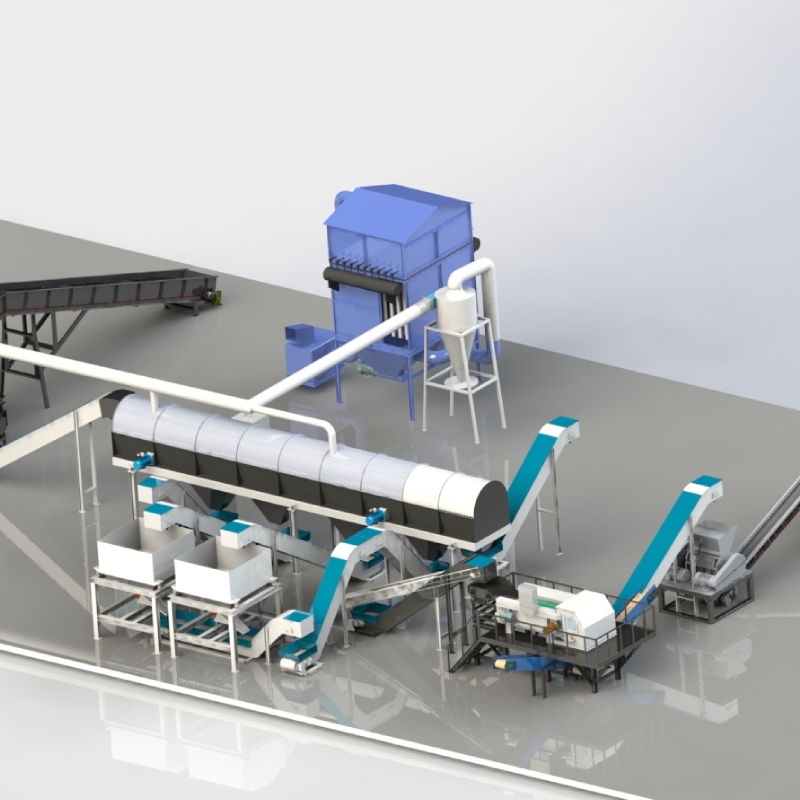
Oct . 07, 2025 11:00 Back to list
If you’ve been hunting for a compact, safer way to process scrap in a garage or maker space, you’ve probably stumbled across the metal shredder for home use topic more than once. To be honest, the category is evolving fast. Knife-based hobby units caught on first; now impact-driven systems—no blades at all—are coming down in size and price, which is intriguing for DIY recyclers and repair shops.

Two shifts stand out: first, impact shredders that “open up” material rather than shearing it. Second, small-footprint units with better guarding and dust control. Many customers say noise and maintenance tripped them up with old knife cutters. Impact rotors reduce knife wear, and that’s not a minor thing; downtime kills enthusiasm in a home shop.
Built in Dafu Village, Qingyuan Town, Qingyuan District, Baoding City, Hebei Province, the Big Vertical Shredder from OW Recycling goes fully knife-less. It uses impact forces to open e‑waste and light metal scrap gently yet quickly—surprisingly effective on aluminum cans, small steel brackets, copper wire harnesses, and phone boards. Compared with conventional cutting systems, users see cleaner liberation, fewer wear parts, and steadier throughput in real-world use.
| Mechanism | Vertical impact rotor with replaceable liners; no knives |
| Throughput | ≈300–700 kg/h (material dependent) |
| Motor power | ≈11–30 kW options; 220/380/480 V configurations |
| Input size | Up to ≈200 mm pieces (cans, brackets, PCB assemblies) |
| Noise | ≈78–88 dB(A) with enclosure; workshop acoustics matter |
| Compliance | Designed toward ISO 12100, EN 60204-1; CE options |
| Service life | Liners ≈1,000–2,500 h; body 8–10 years (typical) |
Best for: detached garages, farm shops, maker spaces, small repair depots, art foundries prepping feedstock. Not ideal for apartments—weight, noise, and dust extraction need space. In fact, you’ll want a simple cyclone or HEPA unit for fines and a magnet for ferrous take-out.
Materials: Al cans, small steel offcuts, brass keys, e‑waste. Method: impact rotor accelerates parts against anvils/liners; a screen defines target size. QC: size check via sieve set (ASTM E11), magnet pull for Fe fraction, visual copper liberation on wire looms. A quick test on mixed can + light brackets yielded ≈520 kg/h, 95% under 25 mm, energy ≈0.12–0.18 kWh/kg (real-world use may vary).
| Model | Core mechanism | Wear profile | Throughput | Best for |
|---|---|---|---|---|
| OW Recycling Big Vertical | Impact, no knives | Low; replaceable liners | Medium (≈300–700 kg/h) | Mixed light metals, e‑waste |
| Compact Knife Shredder (generic) | Dual-shaft knives | Moderate; frequent sharpening | Low–medium | Soft metals, plastics |
| Budget Hobby Unit | Cutter drum | High under steel loads | Low | Occasional cans only |
Options include screen plates (10–40 mm), manganese or chromium-alloy liners, 110/220/380/480 V electrics, sound enclosure, and dust ports. Safety: interlocked lids, e‑stops, proper guarding (ISO 12100, ISO 13857 principles), and compliant panels per EN 60204‑1. For metal dust, follow local fire codes; NFPA 484 guidance is a solid starting point.
A Midwest maker space reports “less fiddling, more shredding,” logging ≈450 kg/h on mixed Al and small steel with a 30% wear reduction versus an old knife unit. An electronics refurb shop uses it to pre‑open boards; copper recovery jumped as liberated pieces feed their downstream separator more consistently. It seems that for a metal shredder for home use, gentle impact is counter‑intuitive but effective.
Match throughput to your power and ventilation. Verify CE/UL conformity, guards, and emergency circuits. Ask vendors for sieve-based test reports and noise readings. If a metal shredder for home use will live near neighbors, invest in an enclosure and a basic dust collector. And yes, plan for magnets and bins—workflow matters more than you think.
Last note: OW Recycling’s vertical impact approach requires less blade maintenance, which—many customers say—keeps weekend projects fun rather than frustrating. For a serious yet compact metal shredder for home use, it’s worth a look.
Latest news
Trusted Double Shaft Shredder Supplier | Durable Industrial & Recycling Solutions
NewsNov.24,2025
Double Shaft Shredder Price Explained: Global Trends, Benefits & Vendor Comparisons
NewsNov.24,2025
Expert Insights into Double Shaft Shredder Factory: Boosting Global Recycling Efficiency
NewsNov.23,2025
Leading Double Shaft Shredder Suppliers for Industrial Recycling and Waste Management
NewsNov.23,2025
Leading Double Shaft Shredder Manufacturers | Durable & Sustainable Industrial Shredders
NewsNov.23,2025
Understanding Double Shaft Shredder Machine Price: Buyers’ Guide & Global Insights
NewsNov.22,2025